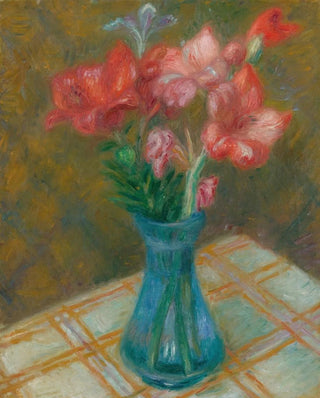Art print | Glaïeul dans un vase en verre vert - William James Glackens


View from behind

Frame (optional)
William James Glackens' artwork "Gladiolus in a Green Glass Vase" embodies the essence of American Impressionism in the early 20th century. This painting, vibrant with color and light, transports us to a universe where nature and art meet with remarkable delicacy. The choice of gladiolus, a flower both majestic and fleeting, highlights the ephemeral beauty of life, while the green glass vase, with its subtle shine, creates a striking contrast that draws the eye. Gazing at this piece, the viewer is invited to immerse themselves in a moment of serenity, to appreciate the simplicity of nature while marveling at the artist's technical mastery.
Style and uniqueness of the work
Glackens' style is distinguished by his bold approach and a palette of vivid colors. In "Gladiolus in a Green Glass Vase," the artist employs fluid brushstrokes and rich nuances to bring the delicate petals of the flower to life. Light plays a predominant role, illuminating the contours of the vase and emphasizing the transparency of the glass. This painting is a true ode to nature, where every detail is carefully studied to create visual harmony. Glackens manages to capture the fleeting beauty of flowers while incorporating a touch of modernity, blending tradition and innovation. The work demonstrates a unique sensitivity, revealing art's ability to transcend everyday life and celebrate the beauty that surrounds us.
The artist and his influence
William James Glackens, a prominent figure of the American Impressionist movement, left a lasting mark on his era through his talent and artistic vision. Born in 1870, he was influenced by contemporaries such as Claude Monet and Pierre-Auguste Renoir, while developing a style that is uniquely his own. Glackens played a key role in introducing Impressionism to America, offering a new perspective on landscape and still life painting. His commitment to depicting daily life and intimate scenes allowed him to stand out in the art world.

Matte finish

View from behind

Frame (optional)
William James Glackens' artwork "Gladiolus in a Green Glass Vase" embodies the essence of American Impressionism in the early 20th century. This painting, vibrant with color and light, transports us to a universe where nature and art meet with remarkable delicacy. The choice of gladiolus, a flower both majestic and fleeting, highlights the ephemeral beauty of life, while the green glass vase, with its subtle shine, creates a striking contrast that draws the eye. Gazing at this piece, the viewer is invited to immerse themselves in a moment of serenity, to appreciate the simplicity of nature while marveling at the artist's technical mastery.
Style and uniqueness of the work
Glackens' style is distinguished by his bold approach and a palette of vivid colors. In "Gladiolus in a Green Glass Vase," the artist employs fluid brushstrokes and rich nuances to bring the delicate petals of the flower to life. Light plays a predominant role, illuminating the contours of the vase and emphasizing the transparency of the glass. This painting is a true ode to nature, where every detail is carefully studied to create visual harmony. Glackens manages to capture the fleeting beauty of flowers while incorporating a touch of modernity, blending tradition and innovation. The work demonstrates a unique sensitivity, revealing art's ability to transcend everyday life and celebrate the beauty that surrounds us.
The artist and his influence
William James Glackens, a prominent figure of the American Impressionist movement, left a lasting mark on his era through his talent and artistic vision. Born in 1870, he was influenced by contemporaries such as Claude Monet and Pierre-Auguste Renoir, while developing a style that is uniquely his own. Glackens played a key role in introducing Impressionism to America, offering a new perspective on landscape and still life painting. His commitment to depicting daily life and intimate scenes allowed him to stand out in the art world.






